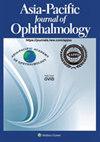一种新型可调节沟型人工晶状体,2年随访临床观察及并发症。
IF 4.5
3区 医学
Q1 OPHTHALMOLOGY
引用次数: 0
摘要
目的:报告一种新型调节型人工晶状体Lumina (AkkoLens clinical b.v, Breda, the Netherlands)在24个月期间的临床结果、观察结果和并发症。方法:这项前瞻性、观察性的多中心研究包括66例患者的103只眼睛,这些患者在两个专业中心接受了Lumina调节型人工晶状体(IOL)的植入术,每个中心采用不同的基于沟的植入术模型。在保加利亚索非亚的Resbiomed-Vissum眼科诊所,54只眼睛使用初始模型进行治疗,其中主要的角膜切口与患者的阳性角膜经络对齐。相比之下,在Vissum Instituto Oftalmológico (Alicante, Spain), 49只眼睛接受了优化模型的治疗,其特点是标准化的水平通道(0-180°),而不考虑角膜地形图。在预定的术后间隔(1天;1、3、6、12和24个月)。系统记录视力和屈光参数,包括UDVA、CDVA、UNVA、BCNVA和cdvva,以及术后观察和并发症。由于在一些基线和术后参数上观察到具有统计学意义的差异,两个队列分别进行分析。结果:术后第1天,21.35%的眼睛出现非严重的临床生物显微镜表现,包括轻度角膜水肿(8.74%)、短暂性高眼压(5.83%)、色素分散(1.94%)、中度人工晶状体倾斜(1.94%)。术后1个月,与手术相关的临床观察率为8.73%,其他发现包括中度人工晶状体脱位和1例黄斑水肿。从第3个月开始,由于1例高眼压,异常结果仍低于1%。12 ~ 24个月异常发生率为2.91%,如色素沉积(1.94%)、人工晶状体脱位(0.97%)、迟发性高眼压(0.97%)。尽管有这些事件,两个基于沟的模型的队列都获得了很好的最终结果。在术后第一个月出现并发症的患者中,24个月时的视力仍然非常好。索菲亚组(中心1):UDVA 0.05±0.13,CDVA -0.08±0.00,UNVA 0.00±0.00,BCNVA 0.00±0.00,CDNVA 0.22±0.11 logMAR。Alicante组(中心2):UDVA为0.04±0.11 logMAR, CDVA为-0.05±0.04,UNVA为0.38±0.18,BCNVA为0.03±0.05,CDNVA为0.34±0.11。结论:Lumina人工晶状体具有良好的长期安全性,无严重的视力不良事件。术后早期观察是短暂的,临床意义不显著,而晚期并发症-虽然可能与晶状体有关-没有损害视力质量。这些发现支持沟植入术用于调节型人工晶状体的解剖学和功能安全性,证实其作为一种有效和稳定的替代囊袋固定的可行性。本文章由计算机程序翻译,如有差异,请以英文原文为准。
A new accommodative sulcus-based intraocular lens, two years follow-up clinical observations and complications
Purpose
To report the clinical outcome, observations and complications related to the sulcus implantations of a new accommodative intraocular lens, the Lumina (AkkoLens Clinical b.v., Breda, The Netherlands) along the twenty-four-month period.
Methods
This prospective, observational multicenter study included 103 eyes from 66 patients who underwent implantation of the Lumina accommodative intraocular lens (IOL) at two specialized centers, each employing a distinct sulcus-based implantation model. At Resbiomed-Vissum Eye Clinic (Sofia, Bulgaria), 54 eyes were treated using the Initial Model, in which the main corneal incision was aligned with the patient’s positive corneal meridian. In contrast, at Vissum Instituto Oftalmológico (Alicante, Spain), 49 eyes were treated with the Optimized Model, characterized by a standardized horizontal access tunnel (0–180°), regardless of corneal topography. Patients were evaluated at predefined postoperative intervals (1 day; 1, 3, 6, 12, and 24 months). Visual and refractive parameters—including UDVA, CDVA, UNVA, BCNVA, and CDNVA—along with postoperative observations and complications, were systematically documented. Due to statistically significant differences observed in several baseline and postoperative parameters, the two cohorts were analyzed separately.
Results
On postoperative day one, non-severe clinical biomicroscopic findings were observed in 21,35 % of eyes, including mild corneal edema (8.74 %), transient ocular hypertension (5.83 %), pigment dispersion (1.94 %), and moderate IOL tilting (1.94 %).
At the first postoperative month, the rate of clinical observations related to the surgery was 8.73 %, with additional findings including moderate IOL decentration and one case of macular edema. From month three onward, abnormal findings such as remained below 1 % due to one case of ocular hypertension. From 12–24 months, the abnormal findings were observed at 2.91 %, such as pigment deposits (1.94 %), IOL decentration (0.97 %), and delayed ocular hypertension (0.97 %). Despite these events, both cohorts with two sulcus-based models achieved excellent final outcomes. Among patients who experienced complications from the first postoperative month onward, visual acuity at 24 months remained highly favorable. In the Sofia group (Center 1): UDVA 0.08 ± 0.05, CDVA − 0.02 ± 0.02, UNVA 0.4 ± 0.15, BCNVA 0.10 ± 0.04, and CDNVA 0.20 ± 0.03 logMAR. In the Alicante group (Center 2): UDVA was 0.04 ± 0.11 logMAR, CDVA − 0.05 ± 0.04, UNVA 0.38 ± 0.18, BCNVA 0.03 ± 0.05, and CDNVA 0.34 ± 0.11.
Conclusion
The Lumina IOL exhibited a favorable long-term safety profile, with no major sight-threatening adverse events. Early postoperative observations were transient and clinically insignificant, while late complications—though likely lens-related—did not compromise visual quality. These findings support the anatomical and functional safety of sulcus implantation for accommodative IOLs, confirming its viability as an effective and stable alternative to capsular bag fixation.
求助全文
通过发布文献求助,成功后即可免费获取论文全文。
去求助
来源期刊

Asia-Pacific Journal of Ophthalmology
OPHTHALMOLOGY-
CiteScore
8.10
自引率
18.20%
发文量
197
审稿时长
6 weeks
期刊介绍:
The Asia-Pacific Journal of Ophthalmology, a bimonthly, peer-reviewed online scientific publication, is an official publication of the Asia-Pacific Academy of Ophthalmology (APAO), a supranational organization which is committed to research, training, learning, publication and knowledge and skill transfers in ophthalmology and visual sciences. The Asia-Pacific Journal of Ophthalmology welcomes review articles on currently hot topics, original, previously unpublished manuscripts describing clinical investigations, clinical observations and clinically relevant laboratory investigations, as well as .perspectives containing personal viewpoints on topics with broad interests. Editorials are published by invitation only. Case reports are generally not considered. The Asia-Pacific Journal of Ophthalmology covers 16 subspecialties and is freely circulated among individual members of the APAO’s member societies, which amounts to a potential readership of over 50,000.
 求助内容:
求助内容: 应助结果提醒方式:
应助结果提醒方式:


